Meet the Triple Ring team and our partners from Evolve Manufacturing at BIOMEDevice in San Jose.
Join us for MedTech Frontiers. Jim Fruchterman, a leading social entrepreneur, will present Technology: Doing Good on Purpose, Rather than Evil (By Accident?)

Technology has immense power to help people. A single-minded focus on profits often requires companies to ignore 95% of humanity for excellent business reasons. Sometimes, companies mistake their economic interest as a valid reason to do things that actively hurt human beings. Our speaker will provide a more optimistic vision of how technologists, entrepreneurs and investors can choose a more positive path, using the innovation tools of Silicon Valley to maximize human benefit while still honoring most of the constraints of our modern capitalist system. He will share his path from helping blow up a private enterprise rocket, building venture-backed machine learning companies in Silicon Valley, and how he found his life’s work adapting the latest tech innovations to serve the other 95% of humanity.
Images are licensed under Creative Commons License.

While the development of medical and pharmaceutical devices not only takes time and money, it is also highly regulated. Selecting the right choice of material and process is essential in order to meet compliance regulations, ensure certification processes and reproducibility, and most importantly, provide a high quality product.
Dr. Bhatt will discuss several medical grade polymer materials which have been developed, exhibiting unique characteristics that offer extraordinary benefits over non-polymeric materials in the modern healthcare system. Additionally, these materials comply with global regulatory requirements that ensure they maintain their integrity without causing secondary and/or long-term complications in the patient. Using a specific case study, “Material Development for a Hip Implant Application”, he will discuss the development process and requirements to wade through the myriad of stages In addition, the following 5 criteria must be evaluated thoroughly: (1) product design and application specifications; (2) material properties and consideration; (3) cost; (4) regulatory and handling aspects; and (5) manufacturing and quality plan(s).
Images are licensed under Creative Commons License.

The concept of Habitable Zone (HZ) was once the only way to estimate the chances of a planet to support life. The past decades of exploration in the Solar System and the study of terrestrial extreme environments have shown that the subsurface and interior of several planets and moons located outside the HZ had – or may still have – conditions suitable for the development and survival of life. Beyond the Solar System, the discovery of thousands of exoplanets gives us a chance to expand our understanding of planetary system formation and evolution, and infer their ability to develop biology. These recent discoveries also give us important information about the probability for the existence of other technologically advanced civilizations in the universe. While the current estimates of life potential, whether simple or complex, are based on concepts such as planetary habitability and the coevolution of life and environment, emerging new theories bridge biology, neuroscience, information technology, and quantum physics, and if verified, would fundamentally change our views on the origin and nature of life, and the meaning of its exploration.
Images are licensed under Creative Commons License.
Somewhere, Somehow, Someone’s Going to Pay…for Gene Therapy
This is a unique point in time for healthcare. After decades of dedicated and dogged research by the scientific and medical communities, we are now seeing FDA approvals of gene therapies which can ease or cure a myriad of debilitating diseases. While biopharma companies seek to recoup their R&D costs, the market will struggle to price these treatments, particularly those developed for small and very targeted patient populations. Who and what will determine the cost to the patient? Big Pharma? Government? Insurers? Payers? Manufacturers? Many would say that the cost is more than just what the market will bear, as it will also need to encourage continued innovation, which is arguably, implicit. The next step is to collectively and thoroughly explore and understand the myriad pieces to this emerging “pie” – from there, the current challenges will be made clear, and we can then proceed in this new frontier.
Images are licensed under Creative Commons License.
Towards Big Data Analytics and the Convergence of AI and High Performance Computing
Established in 1985 as one of the original supercomputer centers funded by the National Science Foundation, the San Diego Supercomputer Center (SDSC) has been an integral part of the supercomputing landscape for almost 35 years. SDSC has been there from the early days of purpose-built supercomputers to the era of “commodity clusters” to the recent trend in heterogeneous architectures (CPUs, GPUs, FPGAs). Along the way, there has been a shift in focus from massively parallel modeling & simulation to big data analytics and the convergence of AI and High Performance Computing. Join us for history, highlighted developments, trends in supercomputing for science, and a review of how SDSC collaborates with industry to benefit both science and commerce.
Ron Hawkins will draw from his 30 years of combined experience as a tech industry executive and academic professional.
Images are licensed under Creative Commons License.

How do we end up doing the work that we do? And why? How do we navigate the myriad of opportunities, challenges, and variables? It seems that one’s path can be both planned and unplanned. Being in an environment where one is surrounded by bright and curious minds, as well as new and traditional technologies, can boggle the mind. How do we choose among the myriad possibilities available? How is one’s career impacted when there is ample hunger, risk, movement, and symbiosis nearby? While education surely opens doors, it is still difficult, particularly at the beginning of one’s career, to predict a path.
Since 1980, when Dr. Sigal completed his studies, his dynamic work path has included academia, big pharma, and biotech start-ups. What did he learn along the way? How did Nolan end up on the “Dark Side” of the biotech world?
Join us as Dr. Sigal shares case studies and experiences, including: (1) moving from academia to industry: (2) discovering the mechanism of action of cyclosporine and FK506 at Merck; (3) the rise and fall of Pharmacopeia; (4) roller coaster rides at various biotech companies; and (5) moving to the investment space. Nolan will share his observations and insights, including remarkable highs and discouraging lows – and how opportunities and decisions, in fact, shape who we are, and subsequent choices we make.
Images are licensed under Creative Commons License.